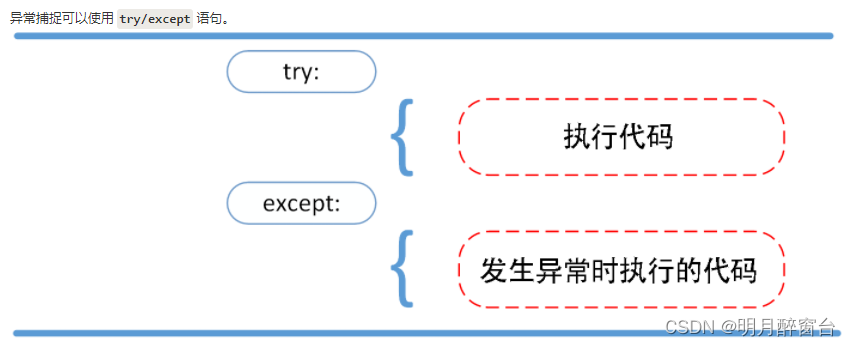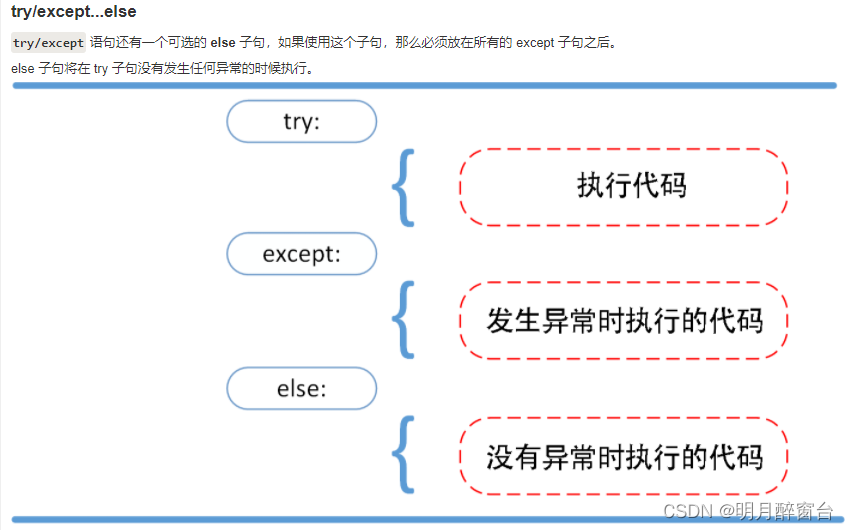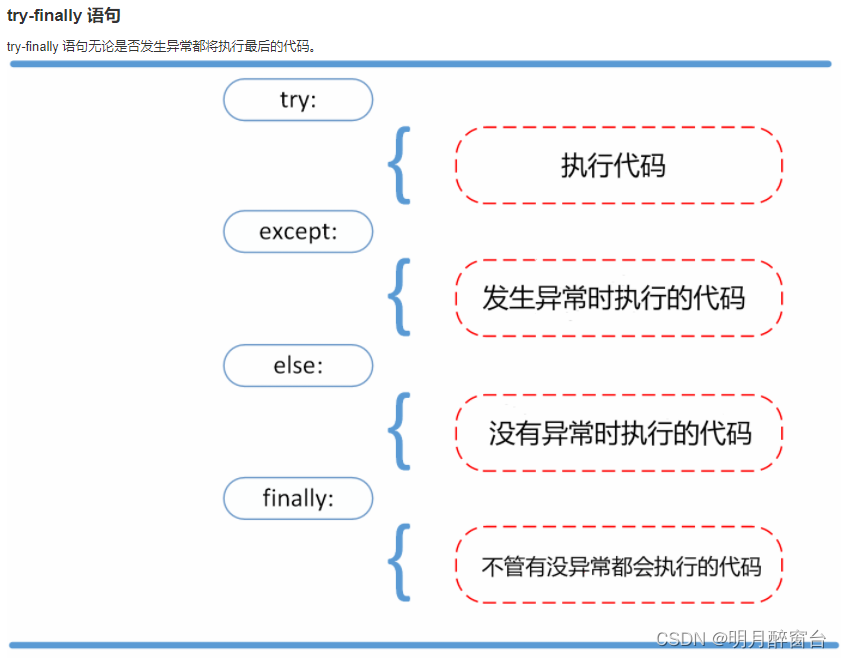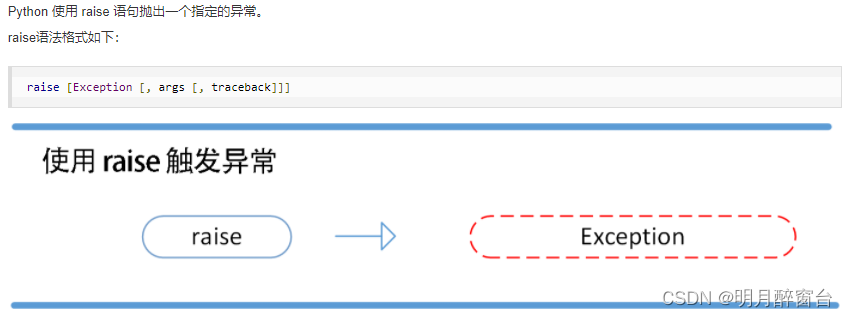1.错误和异常
1.1 异常处理try/except

while True:
try:
x=int(input("请输入一个数字:"))
break
except ValueError:
print("您输入的不是数字,请再次尝试!")

for arg in sys.arg[1:]:
try:
f=open(arg,'r')
except IOError:
print('cannot open',arg)
else:
print(arg,'has',len(f.readlines()),'lines')
f.close()

try:
runoob()
except AssertionError as error:
print(error)
else:
try:
with open('file.log') as file:
read_data=file.read()
except FileNotFoundError as fnf_error:
print(fnf_error)
finally:
print('这句话,无论异常是否都会执行.')
1.2 抛出异常

x=10
if x>5:
raise Exception('x 不能大于 5, x的值为{}.format(x))
*********************执行以上将触发******************************
Traceback (most recent call last):
File "test.py", line 3, in <module>
raise Exception('x 不能大于 5。x 的值为: {}'.format(x))
Exception: x 不能大于 5。x 的值为: 10
1.3 用户自定义异常
class Error(Exception):
"""Base class for exceptions in this module."""
pass
class InputError(Error):
"""Exception raised for errors in the input.
Attributes:
expression -- input expression in which the error occurred
message -- explanation of the error
"""
def __init__(self, expression, message):
self.expression = expression
self.message = message
class TransitionError(Error):
"""Raised when an operation attempts a state transition that's not
allowed.
Attributes:
previous -- state at beginning of transition
next -- attempted new state
message -- explanation of why the specific transition is not allowed
"""
def __init__(self, previous, next, message):
self.previous = previous
self.next = next
self.message = message
2.面向对象Class
**面向对象技术简介**
类(Class): 用来描述具有相同的属性和方法的对象的集合。它定义了该集合中每个对象所共有的属性和方法。对象
是类的实例。
方法:类中定义的函数。
类变量:类变量在整个实例化的对象中是公用的。类变量定义在类中且在函数体之外。类变量通常不作为实例变量使
用。
数据成员:类变量或者实例变量用于处理类及其实例对象的相关的数据。
方法重写:如果从父类继承的方法不能满足子类的需求,可以对其进行改写,这个过程叫方法的覆盖(override),
也称为方法的重写。
局部变量:定义在方法中的变量,只作用于当前实例的类。
实例变量:在类的声明中,属性是用变量来表示的,这种变量就称为实例变量,实例变量就是一个用 self 修饰的变
量。
继承:即一个派生类(derived class)继承基类(base class)的字段和方法。继承也允许把一个派生类的对象作
为一个基类对象对待。例如,有这样一个设计:一个Dog类型的对象派生自Animal类,这是模拟"是一个(is-a)"关
系。
实例化:创建一个类的实例,类的具体对象。
对象:通过类定义的数据结构实例。对象包括两个数据成员(类变量和实例变量)和方法。
2.1类对象
#!/usr/bin/python3
class MyClass:
"""一个简单的类实例"""
i = 12345
def f(self):
return 'hello world'
# 实例化类
x = MyClass()
# 访问类的属性和方法
print("MyClass 类的属性 i 为:", x.i)
print("MyClass 类的方法 f 输出为:", x.f())
******************************************************
#output:
MyClass 类的属性 i 为: 12345
MyClass 类的方法 f 输出为: hello world
2.2 self代表类的实例,而非类
类有一个名为 init() 的特殊方法(构造方法),该方法在类实例化时会自动调用,像下面这样:
def __init__(self):
self.data=[]
类定义了 init() 方法,类的实例化操作会自动调用 init() 方法。如下实例化类 MyClass,对应的 init() 方法就会被调用:
x=MyClass()
当然, init() 方法可以有参数,参数通过 init() 传递到类的实例化操作上。例如:
class Complex:
def __init__(self,realpart,imagpart):
self.r=realpasrt
self.i=imagpart
x=Complex(3.0,-4.5)
print(x.r,x.i)
#output
3.0 -4.5
类的方法与普通的函数只有一个特别的区别——它们必须有一个额外的第一个参数名称, 按照惯例它的名称是 self。
class Test:
def prt(self):
print(self)
print(self.__class__)
t = Test()
t.prt()
******************************************
#output:
<__main__.Test instance at 0x100771878>
__main__.Test
从执行结果可以很明显的看出,self 代表的是类的实例,代表当前对象的地址,而 self.class 则指向类。self 不是 python 关键字,我们把他换成 runoob 也是可以正常执行的:
class Test:
def prt(runoob):
print(runoob)
print(runoob.__class__)
t = Test()
t.prt()
**************************************************
<__main__.Test instance at 0x100771878>
__main__.Test
2.3 类的方法
#类定义
class people:
#定义基本属性
name = ''
age = 0
#定义私有属性,私有属性在类外部无法直接进行访问
__weight = 0
#定义构造方法
def __init__(self,n,a,w):
self.name = n
self.age = a
self.__weight = w
def speak(self):
print("%s 说: 我 %d 岁。" %(self.name,self.age))
# 实例化类
p = people('runoob',10,30)
p.speak()
******************output***********************************
runoob 说: 我 10 岁。
2.4 继承
#!/usr/bin/python3
#类定义
class people:
#定义基本属性
name = ''
age = 0
#定义私有属性,私有属性在类外部无法直接进行访问
__weight = 0
#定义构造方法
def __init__(self,n,a,w):
self.name = n
self.age = a
self.__weight = w
def speak(self):
print("%s 说: 我 %d 岁。" %(self.name,self.age))
#单继承示例
class student(people):
grade = ''
def __init__(self,n,a,w,g):
#调用父类的构函
people.__init__(self,n,a,w)
self.grade = g
#覆写父类的方法
def speak(self):
print("%s 说: 我 %d 岁了,我在读 %d 年级"%(self.name,self.age,self.grade))
s = student('ken',10,60,3)
s.speak()
**********************************************************************************
#output
ken 说: 我 10 岁了,我在读 3 年级
2.5 多继承
#!/usr/bin/python3
#类定义
class people:
#定义基本属性
name = ''
age = 0
#定义私有属性,私有属性在类外部无法直接进行访问
__weight = 0
#定义构造方法
def __init__(self,n,a,w):
self.name = n
self.age = a
self.__weight = w
def speak(self):
print("%s 说: 我 %d 岁。" %(self.name,self.age))
#单继承示例
class student(people):
grade = ''
def __init__(self,n,a,w,g):
#调用父类的构函
people.__init__(self,n,a,w)
self.grade = g
#覆写父类的方法
def speak(self):
print("%s 说: 我 %d 岁了,我在读 %d 年级"%(self.name,self.age,self.grade))
#另一个类,多重继承之前的准备
class speaker():
topic = ''
name = ''
def __init__(self,n,t):
self.name = n
self.topic = t
def speak(self):
print("我叫 %s,我是一个演说家,我演讲的主题是 %s"%(self.name,self.topic))
#多重继承
class sample(speaker,student):
a =''
def __init__(self,n,a,w,g,t):
student.__init__(self,n,a,w,g)
speaker.__init__(self,n,t)
test = sample("Tim",25,80,4,"Python")
test.speak() #方法名同,默认调用的是在括号中参数位置排前父类的方法
************************************************************************************
#output
我叫 Tim,我是一个演说家,我演讲的主题是 Python
2.6 方法重写
如果你的父类方法的功能不能满足你的需求,你可以在子类重写你父类的方法,实例如下:
class Parent:
def myMethod(self):
print('调用父类方法')
class Child(Parent): # 定义子类
def myMethod(self):
print ('调用子类方法')
c = Child() # 子类实例
c.myMethod() # 子类调用重写方法
super(Child,c).myMethod() #用子类对象调用父类已被覆盖的方法
************************************************************************
#output
调用子类方法
调用父类方法
2.7 类的私有属性
__private_attrs:两个下划线开头,声明该属性为私有,不能在类的外部被使用或直接访问。在类内部的方法中使用时 self.__private_attrs。
#!/usr/bin/python3
class JustCounter:
__secretCount = 0 # 私有变量
publicCount = 0 # 公开变量
def count(self):
self.__secretCount += 1
self.publicCount += 1
print (self.__secretCount)
counter = JustCounter()
counter.count()
counter.count()
print (counter.publicCount)
print (counter.__secretCount) # 报错,实例不能访问私有变量
*****************************************************************
#output
1
2
2
Traceback (most recent call last):
File "test.py", line 16, in <module>
print (counter.__secretCount) # 报错,实例不能访问私有变量
AttributeError: 'JustCounter' object has no attribute '__secretCount'
类的专有方法:
__init__ : 构造函数,在生成对象时调用
__del__ : 析构函数,释放对象时使用
__repr__ : 打印,转换
__setitem__ : 按照索引赋值
__getitem__: 按照索引获取值
__len__: 获得长度
__cmp__: 比较运算
__call__: 函数调用
__add__: 加运算
__sub__: 减运算
__mul__: 乘运算
__truediv__: 除运算
__mod__: 求余运算
__pow__: 乘方
2.8 运算符重载:
class Vector:
def __init__(self,a,b):
self.a=a
self.b=b
def __str__(self):
return 'Vector (%d,%d)' % (self.a,self.b)
def __add__(self,other):
return Vector(self.a+other.a,self.b+other.b)
v1=Vector(2,10)
v2=Vector(5,-2)
print(v1+v2)
*********************************************************
#output
Vector(7,8)





 本文详细讲解了Python中的异常处理机制,包括try/except块的使用,自定义异常类,以及面向对象编程中的类、对象、继承、方法重写和私有属性。还涉及了运算符重载、类的构造与析构,以及多继承和方法覆盖实例。
本文详细讲解了Python中的异常处理机制,包括try/except块的使用,自定义异常类,以及面向对象编程中的类、对象、继承、方法重写和私有属性。还涉及了运算符重载、类的构造与析构,以及多继承和方法覆盖实例。


















 542
542

 被折叠的 条评论
为什么被折叠?
被折叠的 条评论
为什么被折叠?










